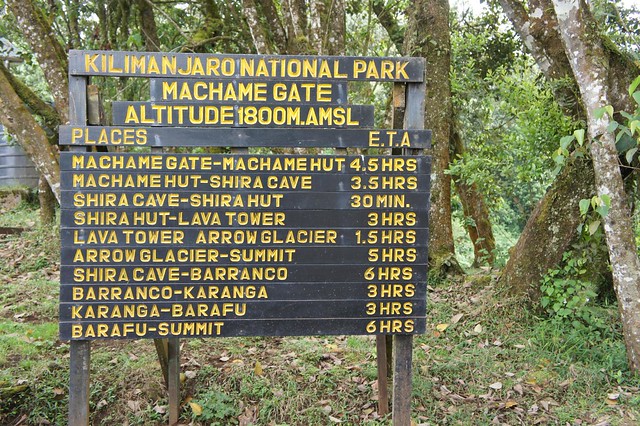Choosing your Kilimanjaro route
There are several routes up Kilimanjaro and the choice can become bewildering. The purpose of this guide is to honestly lay out the pros and cons of each route and aid your decision.

Factors to consider when choosing your Kili route
If you can clarify your priorities the decision becomes relatively easy. Factors to consider when choosing a route include; Your chances of successfully reaching the summit on a given route (some routes offer better acclimatisation and therefore better summit prospects). The likelihood of crowding on the trail. (some routes offer genuine wilderness, others are unfortunately more crowded). The beauty of the route. Some routes offer more variety, more angles of the mountain and more striking views. The cost of the route. (Vehicle, staff and equipment requirements vary by route). How long you'll spend on the mountain
Put simply, in an ideal world speed and cost should not be your primary consideration when choosing a route. The Marangu route offers easily the cheapest prices on the mountain, but that cost saving can be negated by the poor summit prospects, with less than 50% making it to the top. We've tried to tease out the pros and cons of each route. If you make it all the way to the end, we've thrown in our general recommendations, which are of course subject to your interests.
Pros and Cons of Marangu
Marangu is traditionally the most popular route. Nicknamed the coca cola route, there are huts all the way and it is the cheapest option for trekkers on a budget. However, given the low completion rates on Marangu (approx. 42%), it doesn’t necessarily offer the best value for money
Pros of Marangu
- Quickest route
- Cheapest route
- Huts for overnight
- Accessible in the wet season
Cons of Marangu
- Low summit success rates
- Crowds on the trail
- Overcrowded huts with poor sanitation
* Note: Marangu has traditionally been the cheapest option because it was the simplest and easiest for an operator to equip. With a paved road to the gate, huts and communal kitchens, the equipment and staffing requirements are far lower than other routes. It also has a reputation as the least physically demanding route, whilst this may be true it is also offers the worst acclimatisation.
Pros and Cons of Machame
Machame is traditionally known as the most beautiful route on the mountain and has grown in popularity to surpass Marangu. After Marangu it is the most accessible for operators, and is therefore cheaper than other options (barring Marangu). The main draw-back (and only notable criticism) of Machame are over-crowding, particularly where Shira, Old Lemosho and Umbwe converge with Machame at Barranco.
Pros of Machame
- Attractive route
- Accessible in the wet season
- Offers the second greatest chance of summit success behind TK Rongai
Cons of Machame
- Crowding in the high season
Pros and Cons of Lemosho
The traditional Lemosho route is effectively a variant of the Machame route with the only the first two days of the trek differing. It is arguably more beautiful than Machame with more views of Kili than any other route and a true wilderness on the first two days where you are unlikely to see another trekker. With less people around, the chances of a wildlife encounter are also much higher. The big drawback is the bottle-neck at Barranco where it joins the other routes. This can be avoided with the unique TK Lemosho route which is arguably the best option during the peak season, steering clear of the bottleneck and preserving the sense of wilderness right up to the junction of Hans Meyer Cave (well into the assault bid)
Pros of Lemosho
- Attractive route
- Very quiet, particularly on the first two days. (Great option in the peak season)
Cons of Lemosho
- The traditional Lemosho route bottlenecks at Barranco with Machame & Umbwe. (This is avoided in the TK Lemosho route)
- Not possible in the wet season (the approach to the start point by vehicle is not possible)
Pros and Cons of Rongai
The traditional Rongai route is a fairly direct slog offering poor acclimatisation (summit rates as low as 50%). Instead we sell a trek on the unique TK Rongai route, a pioneering route with unparalleled successful summit rates. TK Rongai is our favourite route on Kilimanjaro.
Pros of Rongai
- The best climb high sleep low differential of all routes
- The gentlest approach to high camp
Cons of Rongai
- Summit assault point is shared with climbers from Shira, Lemosho, Machame and Umbwe
- Not possible in the wet season (the approach to the start point by vehicle is not possible)
Pros and Cons of Umbwe
Umbwe is traditionally the hardest route with the poorest altitude acclimatisation. It tends to attract hardier sorts, particularly those attempting the recently re-opened Western Breach.
Pros of Umbwe
- Access to the Western Breach for experienced climbers
Cons of Umbwe
- Poor acclimatisation
- The Western Breach is dangerous
Summary: Our recommended Kilimanjaro routes
Everyone will have different priorities, but to put your reading in context, these are the main routes we usually recommend.
#1 Best for quiet trails in peak season – TK Lemosho
#2 Best for summit chances – TK Rhongai
#3 Best all round – TK Rongai & Machame
Our Kilimanjaro Treks






